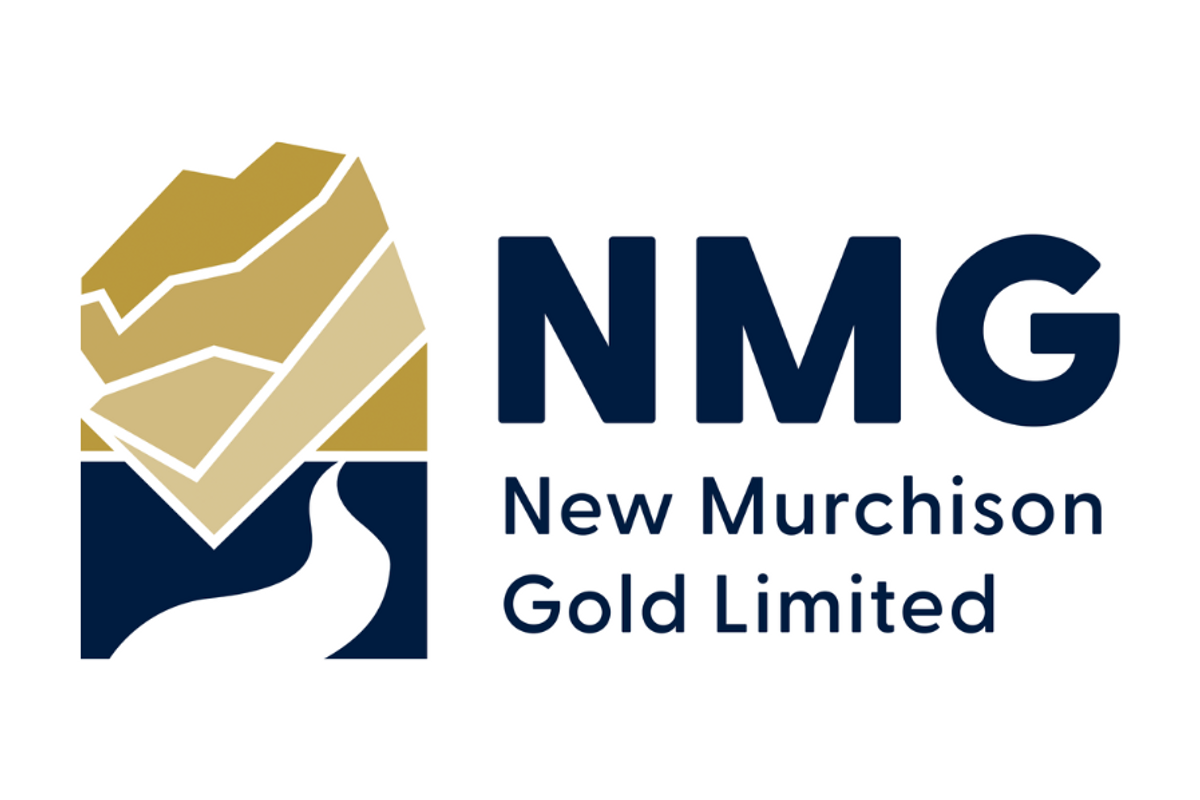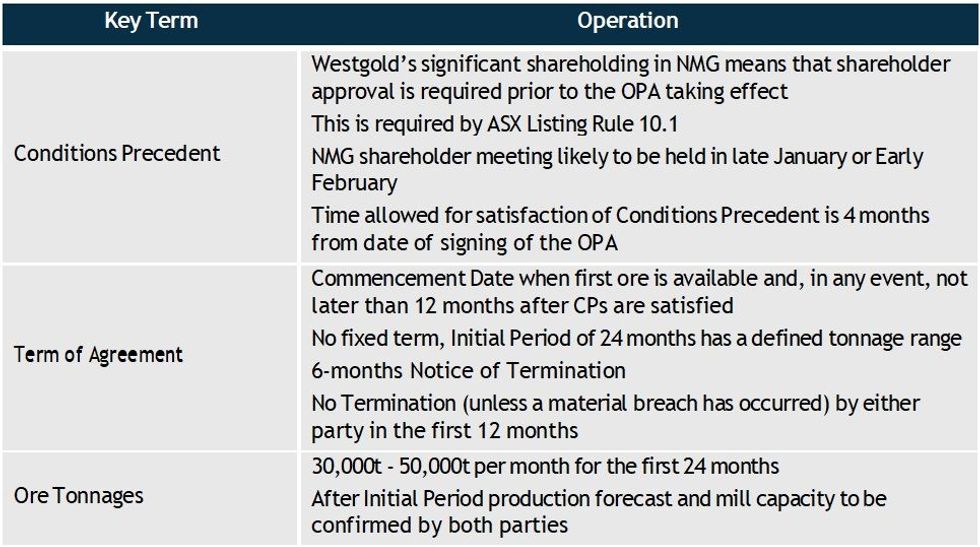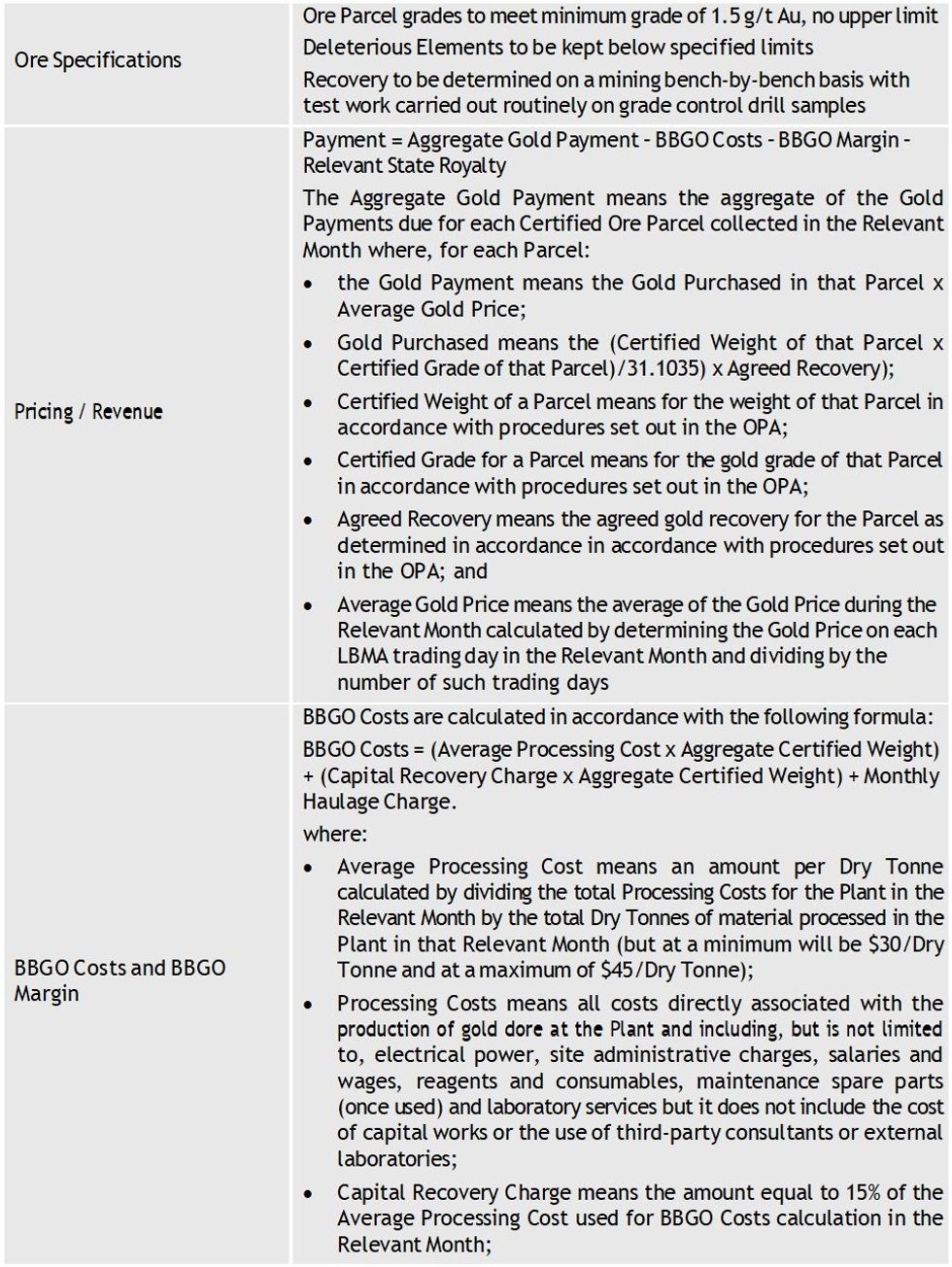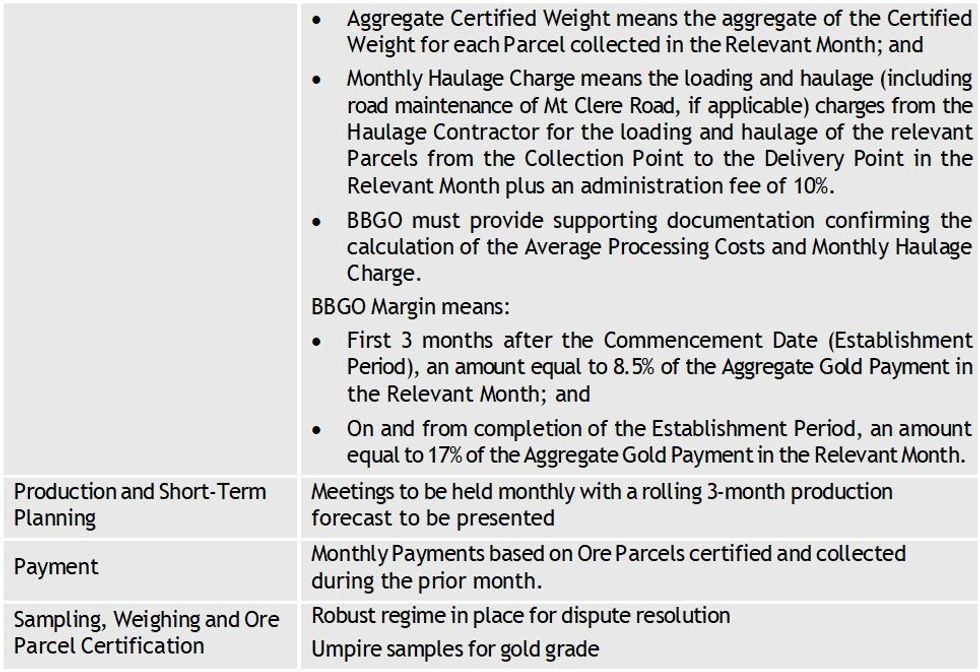- AustraliaNorth AmericaWorld
Investing News NetworkYour trusted source for investing success
- Lithium Outlook
- Oil and Gas Outlook
- Gold Outlook Report
- Uranium Outlook
- Rare Earths Outlook
- All Outlook Reports
- Top Generative AI Stocks
- Top EV Stocks
- Biggest AI Companies
- Biggest Blockchain Stocks
- Biggest Cryptocurrency-mining Stocks
- Biggest Cybersecurity Companies
- Biggest Robotics Companies
- Biggest Social Media Companies
- Biggest Technology ETFs
- Artificial Intellgience ETFs
- Robotics ETFs
- Canadian Cryptocurrency ETFs
- Artificial Intelligence Outlook
- EV Outlook
- Cleantech Outlook
- Crypto Outlook
- Tech Outlook
- All Market Outlook Reports
- Cannabis Weekly Round-Up
- Top Alzheimer's Treatment Stocks
- Top Biotech Stocks
- Top Plant-based Food Stocks
- Biggest Cannabis Stocks
- Biggest Pharma Stocks
- Longevity Stocks to Watch
- Psychedelics Stocks to Watch
- Top Cobalt Stocks
- Small Biotech ETFs to Watch
- Top Life Science ETFs
- Biggest Pharmaceutical ETFs
- Life Science Outlook
- Biotech Outlook
- Cannabis Outlook
- Pharma Outlook
- Psychedelics Outlook
- All Market Outlook Reports
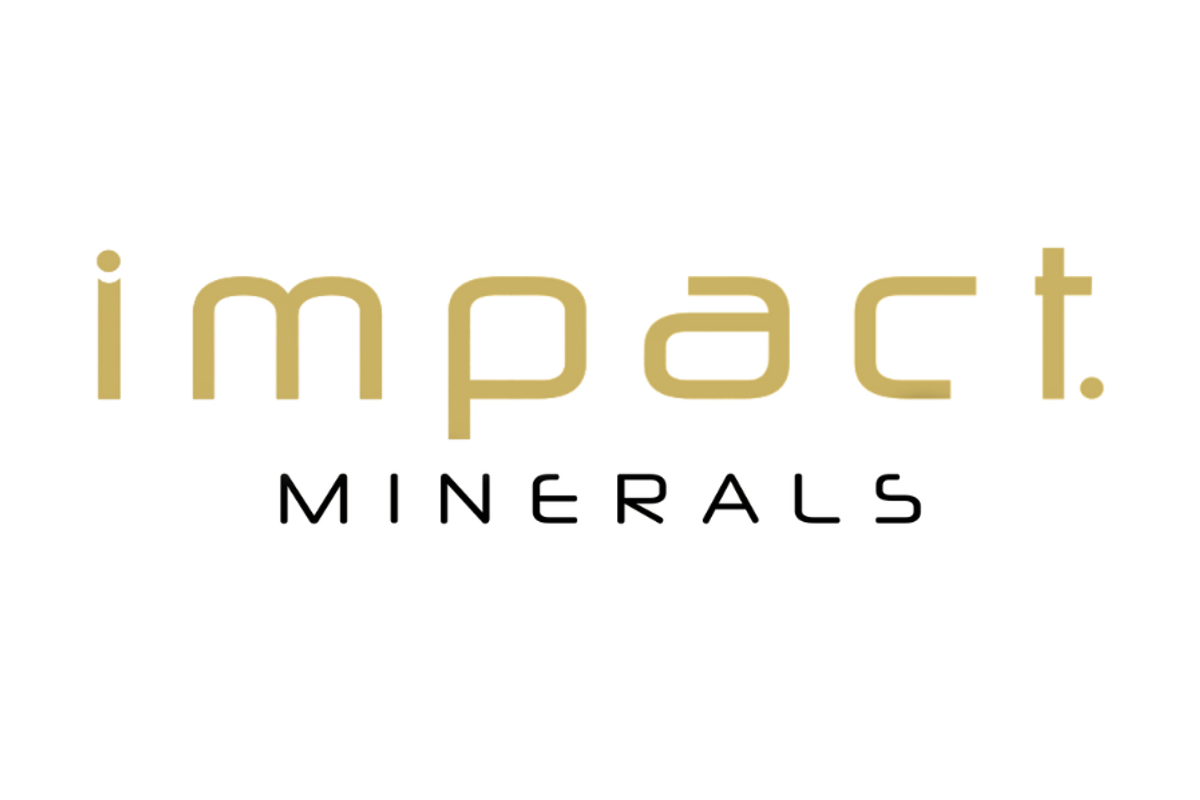
Impact Minerals Limited (ASX: IPT) – Trading Halt
Description
The securities of Impact Minerals Limited (‘IPT’) will be placed in trading halt at the request of IPT, pending it releasing an announcement. Unless ASX decides otherwise, the securities will remain in trading halt until the earlier of the commencement of normal trading on Friday, 5 May 2023 or when the announcement is released to the market.
Issued by
Scarlette de Lavaine
Adviser, Listings Compliance
Click here for the full ASX Release
This article includes content from Impact Minerals, licensed for the purpose of publishing on Investing News Australia. This article does not constitute financial product advice. It is your responsibility to perform proper due diligence before acting upon any information provided here. Please refer to our full disclaimer here.

Impact Minerals Limited Investor Kit
- Corporate info
- Insights
- Growth strategies
- Upcoming projects
GET YOUR FREE INVESTOR KIT
Impact Minerals Limited
Investor Insight
With a mining lease application underway and a scoping study that shows excellent economics, Impact Minerals’ game-changing, advanced Lake Hope high-purity alumina project makes for a compelling investment case.
Overview
Impact Minerals (ASX:IPT) is an exploration and development mining company focused on discovering and developing new resource projects within Australia. Lake Hope, a transformational acquisition by the company and its current flagship asset, is a high-purity alumina (HPA) project in Impact’s home territory of Western Australia, a tier-one jurisdiction.
This advanced-stage project allows the company to fast-track the asset toward development, firmly establishing the company on the road to production and increasing shareholder value.
HPA is a high-value product with various uses in several industries that are key to the transition to a low-carbon world. It is mainly used in LED lighting, micro-LED screens, and ceramic-coated separators in lithium-ion batteries. Both these markets are forecast to grow dramatically over the next decade, and a looming supply shortage is predicted for 2026.
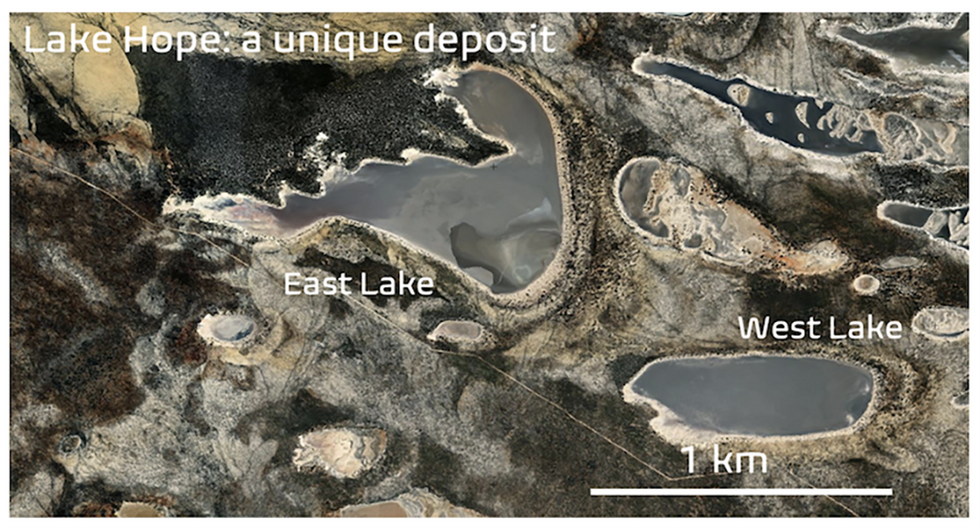
HPA is also necessary for producing synthetic sapphire and scratch-resistant glass. With these ever-widening applications for HPA, demand for this resource is expected to grow from US$3.18 billion to US$12.21 billion by 2030 with a compounded annual growth rate of about 20 percent.
Lake Hope is the company’s current focus as it moves towards production, and where a very shallow, high-grade resource of HPA precursor material has been identified in the top two meters of a dry salt lake. The deposit has unique physical and chemical properties that will allow for inexpensive digging and mining, with transportation to a processing facility off-site in an established industrial area. This will accelerate the approvals processes required to get into production.
With a mining lease application pending, Impact aims to bring Lake Hope, which contains almost 1 million tons of potential HPA, into production when the forecast average price for 4N HPA (99.99 percent Al2O3) and related products is about US$20,000 per ton. The ‘4N’ designation indicates the purity grade, making it suitable for high-tech end uses.
Outstanding economics from the latest scoping study released by the company shows Lake Hope’s potential to be the lowest-cost producer of HPA globally by up to 50 percent.
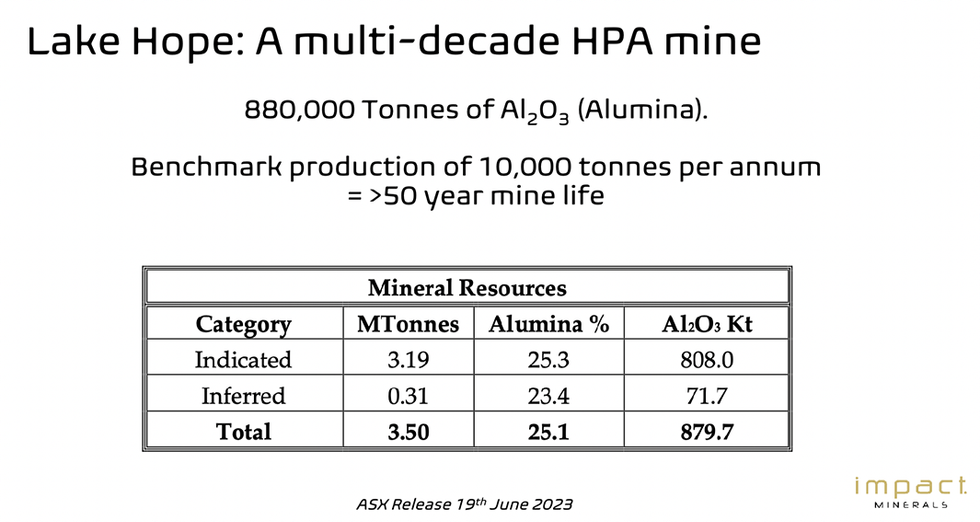
Lake Hope has a maiden mineral resource estimate (MRE) of 3.5 million tons at 25.1 percent alumina (Al2O3) for a contained 880,000 tons of alumina. The company also received heritage clearances for the entire Lake Hope deposit further de-risking the project and providing another critical component in the company’s application for a mining lease.
Impact completed a bulk sampling and test pits program at the Lake Hope project in December 2023, and later reached a key milestone by producing HPA greater than 99.99 percent (4N) purity from the metallurgical processing of lake clays acquired from Lake Hope.
In February 2024, a new proprietary metallurgical process for producing HPA from the lake clays was identified. Impact produced 99.99 percent (4N) Al2O3 from a low-temperature leach (LTL) process. The LTL process may lower the capital and operating costs to produce HPA compared to the sulphate process which underpinned the recent scoping study. The LTL process will be included in the ongoing pre-feasibility study in parallel with the sulphate process at marginal extra cost to determine the best processing route to HPA. The PFS is due to be completed in late 2024.
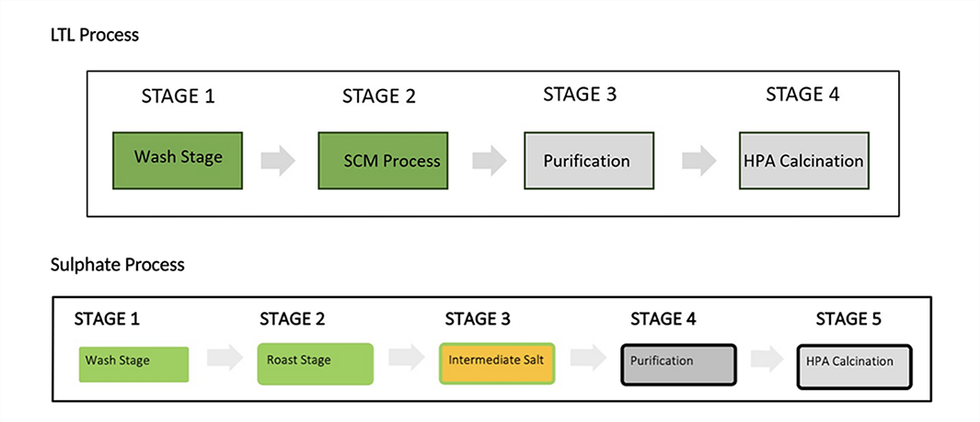
A comparison of the LTL process and the sulphate process
The company is well funded to finance the pre-feasibility study at the Lake Hope High Purity Alumina project and exploration activities at the Arkun battery minerals project.
Impact Minerals has been awarded a $2.87 million grant for the commercialisation of its innovative process to produce High Purity Alumina (HPA) from the Lake Hope deposit. The grant is under the Federal Government’s Cooperative Research Centres Projects (CRC-P) program which fosters short-term, industry-led research collaborations. The grant is part of an estimated $6.4 million research and development project to be completed within three years and designed to provide Impact with the relevant information required to complete a definitive feasibility. A key component of the grant funding will be to construct a pilot plant, which is a key goal for 2025, and this will provide consistent material for off-take and qualification trials.
Impact Minerals was also one of the inaugural cohort of seven companies selected to be part of the prestigious BHP Xplor program. BHP Xplor, an accelerator program introduced by BHP in August 2022, is designed to help provide participants with the opportunity to accelerate their growth and the potential to establish a long-term partnership with BHP and its global network of partners.
The BHP Xplor funding was used to identify new target areas for copper and other energy metals around the Broken Hill area in New South Wales, eastern Australia, where Impact has been quietly adding to its ground position for several years.
Additionally, the company is exploring its large Arkun battery metals project, also in Western Australia which covers nearly 2,900 square kilometres. Three new exploration licence applications were submitted recently immediately north of the Arkun project along trend from the recently discovered REE soil geochemistry anomalies at Hyperion, Swordfish and Horseshoe, and the Caligula copper anomaly. These anomalies require drill testing which will occur in 2024 and is an exciting development in the emerging mineral province of southwest WA.
A strong management team with over 50 years of combined industry experience leads the company. With a mining and exploration geology degree, Dr. Mike Jones, managing director, launched a long career consulting and leading mining organizations. Peter Unsworth, the non-executive chairman, has more than 35 years of experience in multiple financial sectors, such as securities industries and wealth management. Paul Ingram, a non-executive director, has led several mining companies since 2003. Impact Minerals has the experience and expertise to lead the company to success.
Company Highlights
- Impact Minerals is an exploration and development mining company focused on rapidly moving its flagship Lake Hope high-purity alumina (HPA) project toward production.
- The Lake Hope project has a high-grade maiden mineral resource estimate (MRE) of 3.5 million tonnes at 25.1 percent alumina (Al2O3), for a contained 880,000 tonnes of alumina that can be converted to HPA.
- HPA is used throughout multiple industries, and the overall HPA market is projected to grow by a CAGR of 18.4 percent by 2030.
- A pre-feasibility study is currently in progress and scheduled to be completed by Q4 2024. A mining lease application for the Lake Hope High Purity Alumina (HPA) was recently lodged with the aim of being granted by 2026.
- The company’s project portfolio also includes assets with high-grade mineral deposits of a range of base, critical and precious metals.
- Impact Mineral’s 2,000-square-mile Arkun nickel-copper-PGE project in Western Australia has produced encouraging assays that motivate further exploration. Maiden drill programmes are planned for early 2025.
- The company is also exploring its Broken Hill copper project in New South Wales following a major grant under the auspices of the BHP Xplor program in 2023..
- A strong management team leads the company with experience in geology, mining and corporate finance.
Key Projects
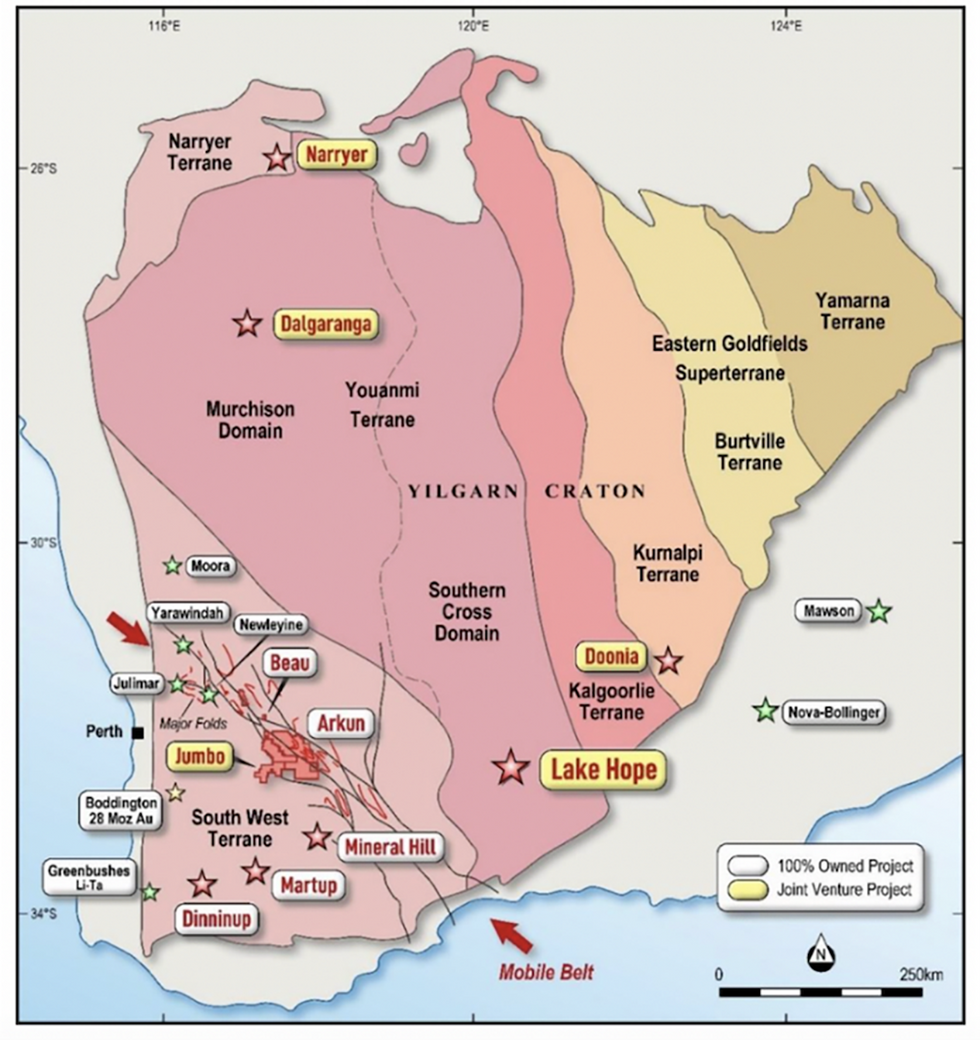
Lake Hope HPA Project
Impact Minerals’ Lake Hope HPA project is in Western Australia, a tier-one mining jurisdiction. HPA is a crucial component in many new and emerging technologies, creating ongoing demand for high-grade sources. The Lake Hope project is the company’s flagship as it moves toward production.
Project Highlights:
- Maiden Mineral Resource Estimate: A maiden mineral resource of 3.5 million tonnes at 25.1 percent alumina (Al2O3) for a contained 880,000 tonnes of alumina has been defined at the Lake Hope HPA Project. About 88 percent of the resource, or 775,000 tonnes of alumina, is in the higher confidence indicated resource category.
- Amenable to Open-pit Mining: The Lake Hope project is a unique HPA asset amenable to shallow, open-pit mining. The deposit is soft and shallow, allowing for cheap digging and minimal infrastructure requirements. This type of deposit also lowers the environmental footprint of the operation.
- Fast-tracked to Production: A mining lease application is currently underway. Once granted, the company will begin working towards a pre-feasibility study and mini pilot plant. Impact Minerals plans to reach a complete pilot plant by 2026.
- Impressive Results of the 2023 Scoping Study: Outstanding economics show Lake Hope to potentially be the lowest-cost producer of High Purity Alumina (HPA) globally by up to 50 percent. Key outcomes from the scoping study include:
- Annual production of 10,000 tpa of 4N HPA with an initial 25-year mine life
- Annual EBITDA of A$174 million.
- 2 years construction period with 5,000 tonnes of production during the first year, 8,000 tonnes in the second year and 10,000 tonnes of production thereafter.
- US$934 million post-tax NPV8 at an IRR of 55 percent.
- Mining Lease Application: Amining lease application was lodged in mid-2024 over the West Lake resource while a miscellaneous licence application (L63/99) was lodged to cover mine infrastructure and haulage road.
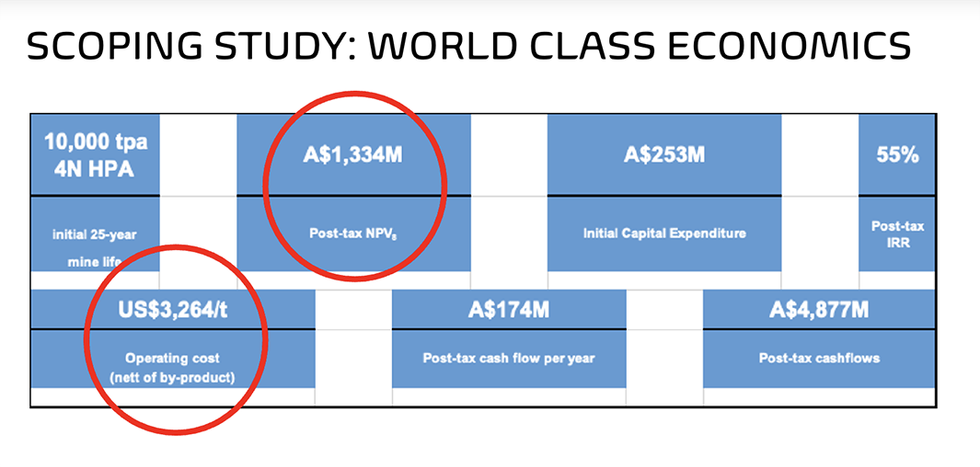
The scoping study was underpinned by a sulphuric acid process allowing the company to achieve a new milestone by producing HPA with purity of more than than 99.99 percent (4N) from the metallurgical processing of lake clays acquired from Lake Hope. The company further identified a new proprietary metallurgical process for producing HPA from the lake clays. Known as the low-temperature leach (LTL) process, this also produced 99.99 percent (4N) Al2O3 and has the potential to lower even further the capital and operating costs to produce HPA compared to the sulphate process. The LTL process will be included in the ongoing pre-feasibility study along with the sulphate process to determine the best processing route to HPA. The PFS is due to be completed in late 2024.
Broken Hill Copper Project
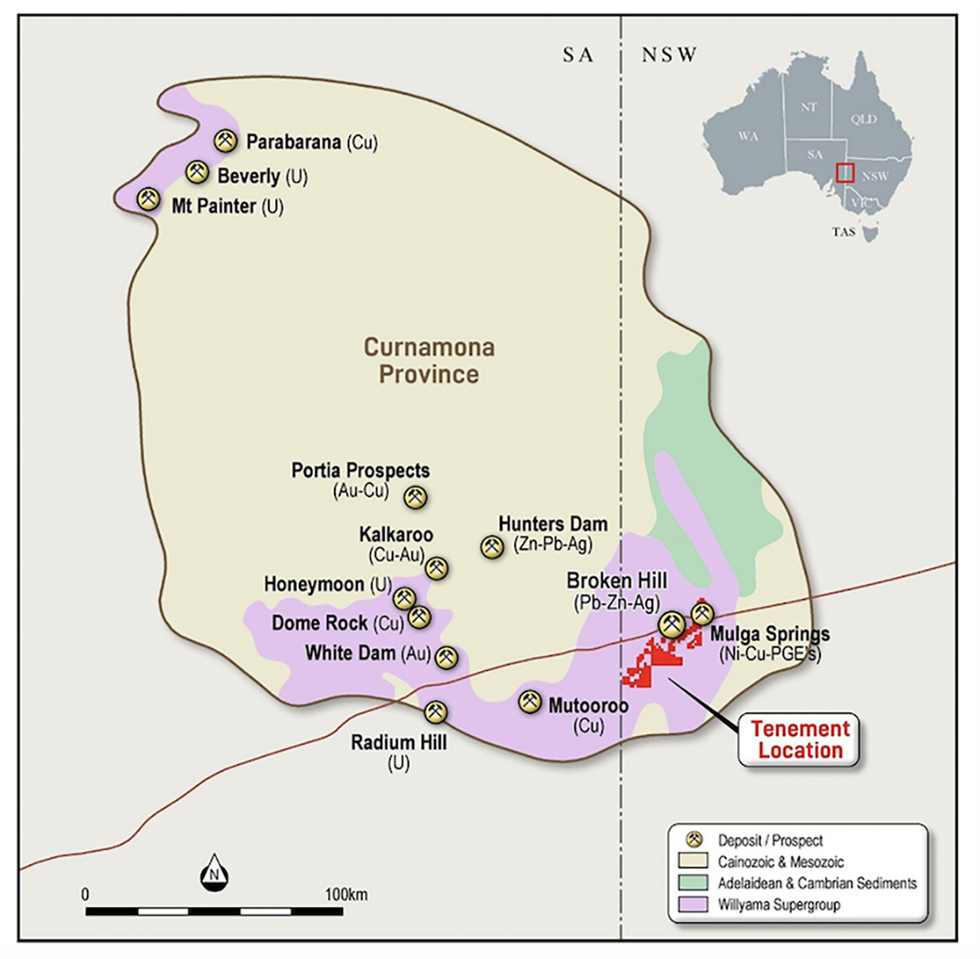
The Broken Hill project has a significant land position of 815 square kilometers and hosts multiple targets with the potential for high-grade copper. Broken Hill is located in New South Wales, Australia, an area known for its prolific silver-lead-zinc mining operations and the giant Broken Hill deposit.
Project Highlights:
- Participant in the BHP Xplor Program: Impact was selected for the BHP Xplor program in 2023 based on its Broken Hill project. The program is designed to allow participants to accelerate growth and establish a long-term partnership with BHP.
- Potential for Additional Minerals and Deposits: As well as copper, the project has significant exploration potential for magmatic nickel-copper-PGE sulphides, and at the time the host rocks were formed, Broken Hill was located close to the world-class nickel-copper-PGE deposit of Jinchuan and the significant Lengquisheng deposit. The project area also has the potential to contain zinc-lead-silver deposits, providing even more value.
Arkun Nickel-Copper-Gold-Lithium-REE Project
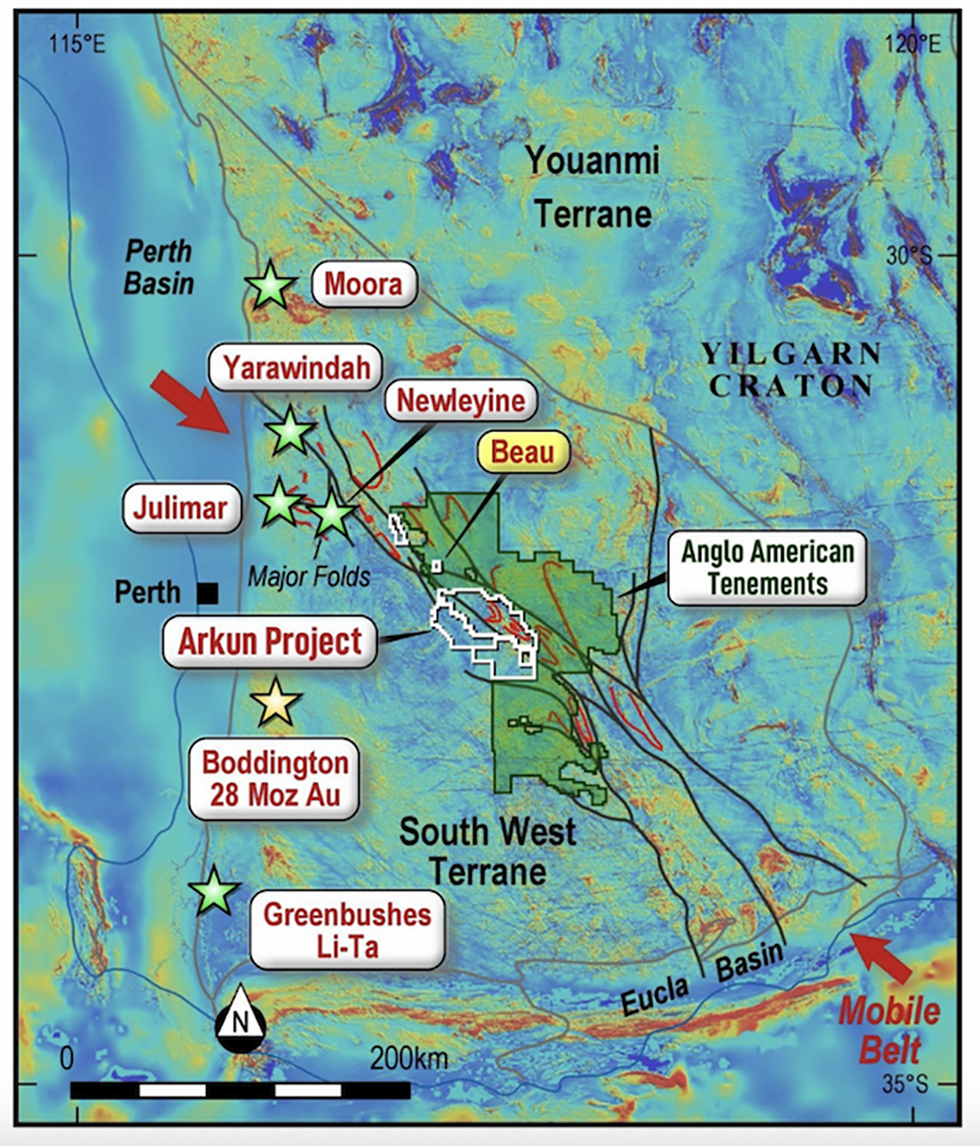
The Arkun project is a 2,900-square-kilometer nickel, copper and gold project located in the emerging Ni-Cu-PGE province near the world-class Julimar Ni-Cu-PGE deposit and surrounded by Anglo American Corporation, which secured its ground holding shortly after Impact secured its asset. Anglo-American is one of the world’s top ten mining companies, and their presence in the region brings confidence in the project’s potential.
Project Highlights:
- Additional Exploration Underway: Impact plans follow-up work programs, including drilling, at its priority targets.
- Significant Targets Identified: Recent soil sampling identified two new prospects:
- Hyperion prospect - Located in the northwestern part of the project area returned with rare earth element anomalism of up to 5,880 ppm (0.59 percent) total rare earth oxide (TREO+Y) and neodymium and praseodymium (Nd+Pr) of up to 21 percent.
- Caligula prospect - Initially identified on the roadside, the Caligula prospect is a large and significant target for porphyry copper mineralisation.
- Three New Exploration Licences: Impact applied for three new exploration licences expanding Arkun project along trend from the recently discovered REE soil geochemistry anomalies at Hyperion, Swordfish and Horseshoe as well as the Caligula copper anomaly.
Management Team
Peter Unsworth - Non-executive Chairman
Peter Unsworth, formerly a chartered accountant, has over 35 years of experience in the corporate finance, investment and securities industries and a wealth of management experience with public and private companies. A former executive director with a leading Western Australian stockbroking company, Unsworth has been a director of several public exploration and mining companies. He recently completed a long time serving as chairman of the Western Australian Government-owned Gold Corporation (operator of The Perth Mint). Unsworth is the founding chairman of Impact Minerals.
Dr. Mike Jones - Managing Director
Dr. Mike Jones is the founding managing director of Impact Minerals Limited, which was listed on the Australian Stock Exchange in November 2006. Reporting to the board of directors, he is responsible for the company's performance as it moves towards production at its Lake Hope High Purity Alumina Project and also for implementing strategies to explore and maximize the value of the company's other extensive tenement holdings.
Since listing, he has helped raise more than $60 million to help fund the exploration of Impact’s projects and managed the company through significant adverse events, including the global financial crisis and the Fukushima nuclear disaster, which affected Impact’s considerable investment in the uranium sector, a five-year global downturn in the mining sector and more recently, the COVID-19 pandemic.
Paul Ingram - Non-executive Director
Paul Ingram is a geologist with extensive experience managing major mineral exploration programs for several publicly listed companies and has been involved in the mining sector for over thirty years. He has designed and implemented innovative techniques for exploration in remote areas and has managed projects in countries throughout Australia and East Asia. Ingram has been a director of the following listed companies in the past three years: Polo Resources from January 2008 to January 2011; A-Cap Resources since June 2009; Consolidated Global Investments since September 2006; Caledon Resources from February 2003 to March 2008; and Australian Pacific Coal since March 2011.
Dr Frank Bierlein - Non-executive Director
Dr. Frank Bierlein is a geologist with 30 years of experience as a consultant, researcher, lecturer and industry professional. Bierlein has held exploration and generative geology management positions with QMSD Mining, Qatar Mining, Afmeco Australia and Areva NC, and consulted for, among others, Newmont Gold, Resolute Mining, Goldfields International, Freeport McMoRan, and the International Atomic Energy Agency. He is currently a non-executive director of PNX Metals. He was previously a non-executive director of Gold Australia NL and chaired the advisory board of a Luxembourg-based private equity fund between 2014 and 2021.
New 1 km Zone of Gold Mineralisation Discovered from RC Drilling at Rockland
Dundas Minerals Limited (ASX: DUN) (“Dundas Minerals”, “Dundas” or “the Company”) is pleased to announce highly encouraging first pass assay results from its recently completed drilling campaign within Mining Lease M 24/974 (‘’Rockland’’), at the Windanya Gold Project.
Highlights
- Assays received from first-pass 23-hole RC drill programme at “Rockland” (M 24/974)
- Discovery of new zone of gold mineralisation between the historic Milford and Windanya North gold prospects, within granted Mining Lease M 24/974
- Gold mineralisation now extends over ~1km along strike
- Best intercepts include:
- 12m @ 1.9g/t gold from 72m, incl 4m @ 3.0g/t from 80m (24RKRC015)
- 16m @ 1.5g/t gold from 68m, incl 4m @ 2.7g/t from 76m (24RKRC005)
- 8m @ 1.8g/t gold from 108m, incl 4m @ 2.7g/t from 112m (24RKRC013)
- 4m @ 1.7g/t gold from 48m (24RKRC019)
- 4m @ 1.5g/t gold from 128m (24RKRC022)
- Previous drilling was mostly limited to 50 metres, and undertaken 25 – 35 years ago
- Planning of a follow-up drill program to target extensions of the 1km long gold trend
- Dundas is also expecting assay results in January 2025, from recently completed drilling at the Baden-Powell gold deposit
Dundas is actively exploring for gold at the Windanya and Baden- Powell projects, located adjacent to the Goldfields Highway ~60km north of Kalgoorlie, Western Australia, and ~15km north of the Paddington gold mill.
Rockland – Drilling Program / Assay Results
All assay results have been received from the 23 hole reverse circulation (RC) drilling program of 3,954 metres, that was completed within the Rockland granted mining lease in October 2024. 11 of the 23 holes drilled returned gold assays above 1.0g/t, from 4m composite samples (Appendix: Table 1).
Commenting on the first pass drill campaign, Dundas managing director Shane Volk said:‘’This is an excellent start from first pass drilling at a project that Dundas acquired an option on only a few months ago. Most of the previous drilling at the project was limited to 50 metres, and undertaken 25-35 years ago when the gold price was below US$500 an ounce.
Results from this first pass program have exceeded expectations. Importantly for the Company, as we seek to grow the size of the gold mineralisation at the Windanya project area, is that Rockland gold mineralisation is within a granted ML located very close to the Goldfields Highway (5km), Kalgoorlie (60km) and multiple operating gold mills, including Paddington (15km).’’
The best assay results from the drill program are:
- 12m @ 1.9g/t gold from 72m, incl 4m @ 3.0 g/t (80-84m): 24RKRC015
- 16m @ 1.5g/t gold from 68m, incl 4m @ 2.7 g/t (76-80m): 24RKRC005
- 8m @ 1.8g/t gold from 108m, incl 4m @ 2.7 g/t (112-116m): 24RKRC013
- 8m @ 1.1g/t gold from 122m: 24RKRC007
- 4m @ 1.7g/t gold from 48m: 24RKRC019
- 4m @ 1.5g/t gold from 128m: 24RKRC022
- 12m @ 1.0g/t gold from 68m: 24RKRC012
Holes were drilled on broad, nominal 150m spaced sections to test mineralisation previously identified in shallow historic RAB and RC drilling, mostly at the Milford and Windanya North gold prospects. Importantly a new mineralised zone has been discovered between these prospects, highlighting a ~1km long gold mineralised trend along the entire length of the ML, and possibly extending north to the Aquarius gold prospect (Figure 1). Mineralisation comprises an oxide supergene zone in the deeply weathered mafic host lithologies, above a series of stacked structures dipping shallowly to the east in the transitional to fresh rock. As illustrated in Figure 1, gold mineralisation is interpreted as trending north – south, which is consistent with the regional trend.
Background – Windanya Gold Project (incl. Rockland)
On 8 October 2024, Dundas Minerals announced that it had executed an exclusive 12 -month option to acquire 100% of granted mining lease (ML) M24/974 (Rockland).
Rockland is strategically situated between Dundas’ Aquarius and Scorpio gold prosects (Figure 1), where on 6 February 2024, Dundas announced high grade gold intercepts from an initial drilling program, including: Aquarius (3m @ 10.2 g/t from 109m; 2m @ 6.5g/t from 70m); and Scorpio (2m@ 3.2 g/t from 9m; 1m @ 6.5g/t from 49m).
The area comprising the Rockland ML has been subject to historic shallow drilling during the 1980s, which was mostly to a maximum depth of 50m (RAB). Also, a series of RAB holes to a maximum depth of ~90m was drilled in the early 2000s, plus 12 RC holes at the Windanya North prospect. More recently the current tenement owner drilled 3 RC holes at depths between 140m and 173m, also at Windanya North. However, the drilling just completed by Dundas Minerals is the first to systematically test for gold mineralisation at Rockland to depths beyond 50m.
Assay results from the Rockland drilling reported in this announcement are from 4 metre composite samples, a cost effective sampling technique commonly used during first-pass exploration drilling. The technique involves taking equal portions of four consecutive 1 metre samples, which are combined to create a single sample for assay. Where gold grades of 0.1g/t or higher were returned from the composite, the Company has submitted the individual 1 metre samples for gold assay (50g Fire assay). Results from these assays are expected in late January 2025, and will provide more definitive and detailed data. Only 2 of the 23 holes drilled (24RKRC002 and 24RKRC003) reported no gold grades above the 0.1g/t threshold with 4 metre composite samples.
Baden-Powell Gold Deposit
Further to the Company’s announcement on 24 November 2024, the 15 hole RC drilling program at the Baden-Powell gold deposit (Figure 2) was completed on 9 December 2024. Assays results from the program are also expected in late January 2025.
Click here for the full ASX Release
This article includes content from Dundas Minerals, licensed for the purpose of publishing on Investing News Australia. This article does not constitute financial product advice. It is your responsibility to perform proper due diligence before acting upon any information provided here. Please refer to our full disclaimer here.
Ore Purchase Agreement with Westgold Resources Unlocks Gold Production from Crown Prince
New Murchison Gold Limited (ASX: NMG) (“NMG” or the “Company”) is pleased to announce that it has entered into a binding agreement with Big Bell Gold Operations Pty Ltd (BBGO), a wholly-owned operating subsidiary of Westgold Resources Limited (ASX: WGX, TSX: WGX, OTCQX: WGXRF) (Westgold) in relation to the purchase of gold ore from the Crown Prince deposit.
HIGHLIGHTS
- New Murchison Gold (NMG) and Westgold Resources (Westgold) have entered into an Ore Purchase Agreement (OPA) which will underpin production from NMG’s Crown Prince deposit near Meekatharra, Western Australia in 2025.
- Subject to final regulatory permitting, under the OPA, NMG will commence mining from a new open pit operation at Crown Prince with a targeted commencement date of mid-2025.
- Ore will be hauled 33km by road to the Bluebird Gold Processing Plant, part of Westgold’s Murchison Gold Operations at Meekatharra.
- Ore will be sold to Westgold in several parcels (Ore Parcels) totalling 30-50kt per month with each Ore Parcel certified for grade, moisture and recovery from sampling at the Crown Prince site and a recovery factor agreed for each mining bench from test work replicating the Bluebird Mill circuit.
- The OPA has no fixed term although NMG envisages that most of Crown Prince ore is likely to be processed in an “Initial Period” which runs over the first 24 months of the agreement. Thereafter ore tonnages are to be agreed on a rolling three-month basis once production forecasts have been completed by NMG and Westgold has confirmed mill availability.
- Westgold will purchase ore from NMG based on contained gold in each Ore Parcel at the prevailing AUD gold price in the month the Ore Parcel is collected (minus processing costs and a capital recovery charge). Westgold must promptly collect Ore Parcels that are available for collection.
- The OPA is subject to shareholder approval (Listing Rule 10.1 requirement) at a general meeting of NMG shareholders to be held in late January or early February 2025.
- NMG and Westgold have also entered into an ancillary agreement (Licence and Access Water Discharge Deed) which facilitates NMG’s potential dewatering requirements at Crown Prince.
Alex Passmore, NMG’s CEO commented: "We are very pleased to announce the Ore Purchase Agreement with Westgold as it sees both companies working together to support the development of NMG’s Crown Prince deposit in a capitally efficient manner.
We see this Agreement as beneficial to all shareholders with Westgold acquiring additional high grade oxide ore feed to supplement its Meekatharra operations and NMG transitioning to a producer for modest capital.
The Bluebird Processing Plant owned by Westgold is ideal for NMG due to its close proximity and well-matched metallurgical process. We believe the robust frameworks and protocols we have put in place in this Agreement aligns both operational teams to a common goal of maximizing operational efficiency.
We thank the Westgold team for the technical and commercial work that has led to this Agreement and look forward to working collaboratively in making the development of Crown Prince a success”
Crown Prince is located to the north of Meekatharra, around 33km via road to the Bluebird Gold Processing Plant (Bluebird) owned and operated by BBGO. Westgold and NMG have been working collaboratively on the OPA to manage technical risks and to share economic synergies which are available via the partnering of production from the Crown Prince deposit and milling at Bluebird.
Key Terms of the OPA are outlined in the Table below and will be explained fully in a Notice of Meeting to be sent to NMG shareholders in December. The NMG shareholder meeting is likely to be held in late January or early February 2025. As a result of Westgold’s 18.7% ownership of NMG, it is deemed a related party under the ASX Listing Rules and so the OPA includes a condition precedent of NMG obtaining shareholder approval under Listing Rule 10.1.
BDO Corporate Finance Australia Pty Ltd (BDO) has been engaged to provide an opinion and Independent Expert’s Report to accompany the Notice of Meeting to assist shareholders in their considerations of whether or not to approve the OPA moving into operation.
Should the conditions precedent be met (shareholder approval) the OPA will come into effect with NMG expecting mining approvals to be received in early April 2025. Once mining operations commence, and ore stockpiles are built up, it is anticipated that first Ore Parcel sales will occur in September 2025.
The company is working towards an ore reserve estimate to provide further detail on the economics of the project which is to be released shortly.
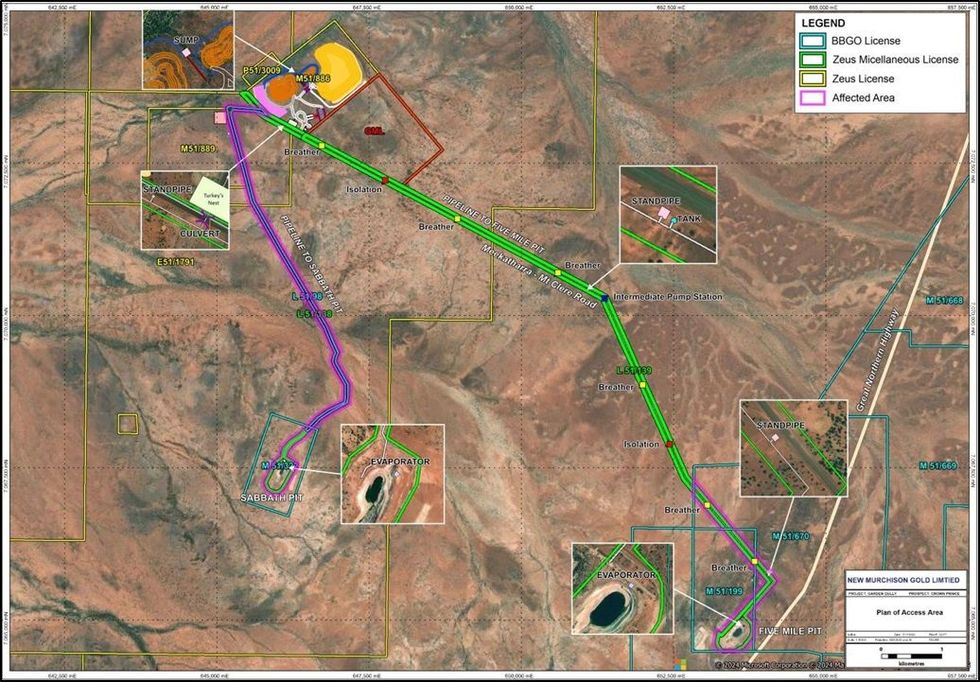
Authorised for release to ASX by the Board of New Murchison Gold Limited.
Click here for the full ASX Release
This article includes content from New Murchison Gold Limited, licensed for the purpose of publishing on Investing News Australia. This article does not constitute financial product advice. It is your responsibility to perform proper due diligence before acting upon any information provided here. Please refer to our full disclaimer here.
Gold Price Forecast: Top Trends That Will Affect Gold in 2025
The gold price saw incredible momentum in 2024, gaining almost 30 percent during the period.
As the start of 2025 approaches, the world is facing a great deal of uncertainty. Several regions are experiencing geopolitical instability, and a new US president could bring further chaos to an already fragile global economy.
What does this mean for gold, and what should investors expect in the new year?
How will Trump affect the gold price in 2025?
A key question for investors is how Donald Trump's second term will affect gold.
Trump’s campaign promises included lower taxes, the introduction of broad tariffs on foreign goods and sweeping immigration reforms that would result in the deportation of millions of undocumented laborers.
Economists widely view his promises as inflationary. They come at a time when the US and global economies are still recovering from high inflation caused by COVID-19, and could cause a delay in lowering interest rates.
While gold is viewed as an inflation hedge, high interest rates imposed by central banks over the past three years have pushed investors toward interest-bearing assets like bonds; meanwhile, gold based-products have seen outflows.
The US Federal Reserve is expected to pause rate cuts in 2025, with analysts speculating that it’s taking a wait-and-see approach to the effects that Trump’s policies will have on the US economy.
In an email to the Investing News Network (INN), Lobo Tiggre, CEO of IndependentSpeculator.com, noted that investor sentiment still reflects uncertainty about what this means.
“People could get so optimistic about Trump’s 'pro-growth' agenda that investors start deploying more of the mountain of cash they’re sitting on ... but Elon and Vivek going to Washington with Milei’s chainsaw could scare markets,” he said.
David Barrett, CEO of EBC Financial Group UK, also expressed uncertainty to INN.
“Trump likes to keep the opposition, domestic or foreign, on edge. His unpredictability is his weapon of choice. Looking at some of his administration picks and the potential clash with the Federal Reserve, I suspect taking a hard view on sentiment for 2025 is not a wise game for now,” he said via email.
Barrett suggested that investors hold some money on the sidelines until they can determine how Trump’s presidency begins and whether his return lives up to his pre-election promises, especially regarding conflicts overseas.
Geopolitical pressures in play for gold
Trump’s return to the White House is just one of the geopolitical situations that could affect gold in 2025.
In 2024, ongoing conflicts in the Middle East and Eastern Europe influenced the price of gold, most notably when Russian President Vladimir Putin floated the possibility of a nuclear escalation in November.
Tiggre noted that flareups tend to drive gold, but the effects are usually temporary and revert back to trend.
“Fortunately, that trend is currently upward. I suppose that if Trump could actually end the war in Ukraine in a day, there might be a bit less safe-haven demand, but I don’t believe he can," he explained.
"So even if gold retreats after each successive scare, there’s no real downside for gold here."
However, Tiggre added that if one of the conflicts in Gaza, Ukraine or even Taiwan were to escalate into a direct military conflict between major world powers, it would likely send gold “screaming” upward.
Central banks still a key driver for gold
The last few years have been characterized by strong central bank buying of gold.
Asia, the Middle East and some Eastern European countries are leading the way. Although not all countries report their purchases, the ones that do are carefully tracked by the World Gold Council.
Although there appeared to be a slowdown in central bank buying in the middle of the year, Joe Cavatoni, senior market strategist, Americas, at the World Gold Council, said it rebounded strongly at the end of 2024.
"In October, we saw a rebound in central bank buying, with 60 metric tons of net purchases; this was the highest monthly amount reported year-to-date, at a time when the gold price was still making gains,” he said.
Looking forward to 2025, Cavatoni said he expects central banks to still be a major driver for the price of gold even though the metal is priced near all-time highs. “This continued interest reaffirms gold’s role as a strategic asset that goes beyond the price to manage risks and diversify reserves,” he said.
In comments to INN, Julia Kandoshko, CEO of European brokerage firm Mind Money, echoed a similar sentiment.
“The growing share of India and the Middle East in global GDP has an additional impact on the demand for gold, especially given the increasing use of gold as a reserve in these areas,” she said.
The scale of central bank purchases has provided gold with a critical support structure, and has also fueled speculation that the precious metal may be used to back an alternative reserve currency to the US dollar.
Barrett suggested this trend has been ongoing for the past 15 years.
He said central banks have been net buyers of gold since 2010 at about 7,000 metric tons. As the ultimate buy-and-hold participant, their activity has not only removed significant supply from the market, but has also contributed to current market conditions, which have made gold attractive to a wide audience.
Gold M&A activity lagging despite price strength
Tiggre expressed surprise at the lack of deals in the gold space given current high prices.
“The larger players simply have not made enough discoveries. If they don’t want to mine themselves out of existence, they’re going to have to buy more of the companies that have done the work,” he said.
Kandoshko echoed this sentiment, saying mergers are a means for larger companies to access exploration projects, expand reserves and optimize costs. She believes 2024's higher prices could pave the way for deals in 2025.
Barrett believes mergers haven’t happened for a myriad of reasons, chiefly that the price of gold hasn’t reached the level to overcome the economic factors that have driven industry costs over the last several years.
“I suspect the main reason is the massive rise in production costs and higher interest rates … labor, energy and raw materials have all risen significantly,” he said. The implication is that higher returns have yet to be realized — gold miners still haven't overcome higher operating costs due to today's economic situation.
Investor takeaway
Central banks are expected to continue supporting the gold price in 2025; however, with Trump entering office, his policies could pull gold in different directions. It may be hard for investors to know what to do.
Cavatoni suggested that a strong US economy and lower deficit under Trump would push the dollar higher, leading to investors seeking to add riskier assets to their portfolios. “If this is what develops as a reaction to Trump’s mandate, it would be supportive to gold allocations as a safe haven,” he said.
For her part, Khandoshko sees gold maintaining its upward momentum, saying she sees the metal increasing to US$2,800 in the next six months and rising to US$3,000 at some point during the new year.
Although reluctant to make a prediction, Tiggre also believes gold will trend higher in 2025.
“How much higher? It is hard to say, but a real all-time-high of just under US$3,500 is less than 35 percent higher than where we are today. That seems doable,” he said.
If gold continues moving up, it could give gold companies the boost they need and could create new opportunities for investors who have been taking a wait-and-see approach.
Maybe more than ever, 2025 is bringing political and economic uncertainty that could see strategies compete between pursuing riskier equities or adding more exposure to gold through bullion or gold-backed products.
The smart play may be to not jump into 2025 headfirst and instead take some time to see how key situations develop through the first part of the year.
Don't forget to follow us @INN_Resource for real-time updates!
Securities Disclosure: I, Dean Belder, hold no direct investment interest in any company mentioned in this article.
Editorial Disclosure: Riverside Resources, Ramp Metals and Rua Gold are clients of the Investing News Network. This article is not paid-for content.
The Investing News Network does not guarantee the accuracy or thoroughness of the information reported in the interviews it conducts. The opinions expressed in these interviews do not reflect the opinions of the Investing News Network and do not constitute investment advice. All readers are encouraged to perform their own due diligence.
Affiliate Disclosure: The Investing News Network may earn commission from qualifying purchases or actions made through the links or advertisements on this page.
Rick Rule and Friends Give Investors the “Gift” of Stock Picks in New Orleans
While prices for key metals have been moving this year, many resource sector investors have been disappointed that mining stocks haven't performed as strongly as they would have hoped in these circumstances.
During the popular mining share panel at the New Orleans Investment Conference, moderator and well-known resource sector investor and speculator Rick Rule invited the panelists to offer insights on the cause of this discrepancy, which has raised questions about market fundamentals and the true drivers of valuation in the sector.
The group, made up of Nick Hodge, Brien Lundin, Lawrence Lepard, Lobo Tiggre and Jennifer Shaigec, also discussed when the tide may turn for mining stocks and which companies they are investing in or watching.
When will mining stocks catch up to metals prices?
Kicking off the discussion, Rule, who is the proprietor at Rule Investment Media, asked the panelists if the discrepancy between metals prices and the performance of mining stocks will end — and if so, when and why.
Nick Hodge, publisher at Digest Publishing, was first to weigh in, saying, “Yes, it will."
As for when, Hodge anticipates more balance in mining shares once “the everything bubble ends.”
He explained that many assets, including tech stocks like the Magnificent 7, are overvalued, causing many of these assets to outperform the S&P/TSX Venture Composite Index (INDEXTSI:JX).
“I think once you get a — I don't want to say crash — once you get a sort of reckoning, a popping of the everything bubble, everything sort of resets," Hodge told the audience.
Lawrence Lepard, managing director Equity Management Associates, suggested the disjointment between metals prices and stock performances is the result of skepticism about current gold and silver projections.
“You look at Bloomberg, you look at the projections — everyone thinks gold is going back to US$2,000 (per ounce), they don't think this move is real,” he said. “We all know it's going to US$3,000 to US$5,000 and that has to change.”
Gold has sat firmly above the US$2,000 level since February, setting a record of US$2,788.54 in October.
For Lepard, the cynical view that gold will retreat is affecting sentiment. Additionally, concerns about rising all-in sustaining costs squeezing miners' margins is adding to the uncertainty.
In terms of a time frame, Lepard echoed Hodge’s position that a major reset is close.
“We're very close to this everything bubble bursting. I think they're going to probably try and pop the bubble to screw (Donald) Trump. I would expect that in the next six months, things are going to change dramatically in this area."
Gold Newsletter editor Brien Lundin thinks there is a different underlying factor contributing to the imbalance.
“There is a discrepancy, but it's more perception than reality,” said Lundin, who also hosts the New Orleans Investment Conference. “If you look at the ratios, the mining stocks, at least judged by the major indexes, have generally outperformed gold, just not as much as we would have expected given the movement in metals.”
He then pointed to the large gold purchases central banks have made in 2024.
“That move in the metals, though, was instigated by central banks buying hand over fist for the first couple of months of the move,” said Lundin. “And central banks don't buy mining stocks.”
According to data from the World Gold Council, by the end of Q3, global central banks had purchased 694 metric tons of gold since the start of the year. Leading the buying were India, Turkey and Poland.
Next in line to answer Rule’s query was Jennifer Shaigec, principal at Sandpiper Trading.
She reiterated Hodge’s “everything bubble bursting” as a catalyst for mining stocks to move.
“Given all the insider sales we've seen from people like (Jeff) Bezos, and Warren Buffet sitting on a big pile of cash, that tells me it's probably imminent,” she told the conference crowd.
“I think there's just a lot of disbelief right now that this move in gold is real … even the base metals (like) copper went up and went back down,” Shaigec added. “There's so much uncertainty on a geopolitical basis that it's going to take some of that to kind of settle in. And I think that could be a little while yet.”
For Shaigec, President-elect Trump’s inauguration is “going to answer a lot of questions for people,” and will likely serve as the tipping point for some of the aforementioned activity.
Lobo Tiggre, CEO of IndependentSpeculator.com,argued that gold stocks are already moving, but “with a caveat.” While there was an expectation that they would move at US$2,500 gold, that's not what happened.
“I think what it took was actually US$2,800 (gold), and that was so far above what anybody thought at the time,” he said, noting that the VanEck Gold Miners ETF (ARCA:GDX) is a poor performance indicator.
“The GDX, it's an ETF, it's defined by size, not quality,” said Tiggre. “(Because) it has some high performers, some low performers, the average number is not real. It's not going to tell you what's going on.”
He continued, “(At) US$2800, you started to see the higher-quality stuff, not just the big producers, but even the juniors — if there is such a thing as a high-quality junior — they really responded. We started seeing hockey sticks.”
Tiggre went on to highlight that for stock pickers, the momentum may already be underway, with the market experiencing a correction phase that’s part of a recurring cycle. The expectation is that these patterns of rise and correction will persist, signaling that while some of the movement has happened, further gains are likely ahead.
Bull market trajectory and top investment themes
Rule then turned to what trajectory a bull market in precious or industrial metals will take.
Overall, the panelists agreed that the traditional progression — where metals prices move first, followed by major producers and down the chain to juniors — will still play out, but perhaps with deviations.
Hodge noted that human nature hasn't changed, so the psychology of investors gravitating to the biggest names first may still hold true. However, he said the rise of "meme stocks" in mining could disrupt the normal trajectory.
Shaigec pointed out that the majors have been paying down debt and accumulating cash, which could lead to more acquisitions of promising development projects. This could light the junior sector on fire.
For their part, Lundin and Lepard both suggested that silver stocks may jump ahead of the typical order, outperforming as investors start to recognize that the white metal is in a true bull market.
Tiggre took a slightly contrarian view, arguing that the discrepancy between metals prices and mining equities has already been addressed for higher-quality companies.
Moderator Rule also asked the panelists for their favorite commodity to express in the equities market.
Tiggre underscored the “pre-production sweet spot” as his favourite investment thesis.
“It's developers,” he said. “But like real developers — you have a construction decision, you have the money, you have the permits. You're going to build a mine.”
Shaigec highlighted two themes, the first being the exciting opportunities that may emerge from drill plays, particularly as new discoveries have declined by 80 percent over the past 15 years.
This depletion of reserves is likely to drive major mining companies to seek fresh resources urgently, creating a significant push for exploration and reserve replacement efforts.
She then spoke about jurisdiction, pointing to the “incredible value to be found in Peru.”
“There's a lot of really exciting projects that have strong management teams in Peru. So that's kind of my favorite theme right now, I'm pretty heavily invested in that country,” said Shaigec.
Taking a more macro view, Lundin spoke about the growing relevance of optionality plays in mining.
“Basically, you buy cheap resources when they're out of favor in the ground and the metals prices aren't enough to justify their development. So you're gaining leverage on a rise in metals prices,” he said.
“(The hope is) that metals prices will rise enough that those ounces in the ground suddenly become economic and therefore very valuable — much more valuable than they were.”
Lepard’s favorite investment thesis is picking companies with strong corporate governance.
“My one thing would be good management,” said Lepard. “This industry is a very tough industry, and there are a million ways to lose money. I found them all. I really have.”
Lastly, Hodge drove home the importance of share structure. “Structure allows you to weather the storm. No matter what the theme is, no matter what the commodity is, the share structure really matters,” he said.
He also suggested that integration of technology could underpin a strong investment thesis.
Hodge explained that the mining industry is rapidly using advanced technology to adapt to new demands and regulations. Innovations like Ceibo’s “clean copper” technology, already adopted by Glencore (LSE:GLEN,OTC Pink:GLCNF), and advances from companies like Rio Tinto (ASX:RIO,NYSE:RIO,LSE:RIO) are reshaping the sector.
“You know, there's going to be battery passports required to be able to track all this stuff. I think that's really going to have to be one of the components of how you look at these mining companies,” said Hodge.
Stock picks from Hodge, Lepard, Lundin and Shaigec
To end the discussion, Rule asked the panelists for a favor.
“I'm a highly competitive person, and I really want this panel to be what everybody thinks is the most important product at the New Orleans Investment Conference,” he said. "In order for that to happen, we've got to give these folks a gift.”
Rule then asked the participants to provide some stock picks for the audience.
For Hodge, Mexico-focused silver company Kingsmen Resources (TSXV:KNG,OTCQB:KNGRF) has a share structure that he likes. He also mentioned Canadian lithium junior Q2 Metals (TSXV:QTWO), noting the company is on “a pretty robust lithium discovery" that may rival that of Patriot Battery Metals (TSX:PMET,OTCQX:PMETF).
Lepard kept it brief and started with Avino Silver & Gold Mines (TSX:ASM,NYSEAMERICAN:ASM), which he “loves.” He then referenced Banyan Gold’s (TSXV:BYN,OTCQB:BYAGF) “huge optionality” and “big deposit.”
Lundin praised the technical team at Relevant Gold (TSXV:RGC,OTCQB:RGCCF), noting that company has “high potential” due to its large percentage of an Abitibi-style district in Wyoming.
He also likes the drill results that Delta Resources (TSXV:DLTA,OTC Pink:DTARF) has been releasing.
Shaigec’s stock picks reflected her Peru-focused investment thesis.
“The first one is CopperEX (TSXV:CUEX),” she said. “One of the things I love about that story is it probably has the largest number of all stars on a team that I have seen assembled under one company name.”
Shaigec selected Coppernico Metals (TSX:COPR,OTCQB:CPPMF) as her second pick. Not only is she impressed by the company’s Sombrero project in Peru, but she also highlighted that several majors have invested in the company.
“(Coppernico) was just listed in August. And just prior to their listing, it was announced that Teck Resources (TSX:TECK.A,TSX:TECK.B,NYSE:TECK) is a strategic shareholder. They own 9.9 percent of the company, and Newmont (TSX:NGT,NYSE:NEM) owns over 6 percent," she said.
Keep an eye out for the rest of INN’s coverage from the New Orleans Investment Conference, including exclusive video interviews and full panel overviews.
Don't forget to follow us @INN_Resource for real-time updates!
Securities Disclosure: I, Georgia Williams, hold no direct investment interest in any company mentioned in this article.
Jp Cortez: Gold, Silver in Sound Money Renaissance, Bullish on Prices and Progress
Speaking to the Investing News Network, Jp Cortez, executive director at Sound Money Defense League, discussed the state of sound money in the US, honing in on key state-level victories this year.
He highlighted that seven states in the country passed various types of sound money legislation. Some removed taxes on precious metals, while others reaffirmed gold and silver as legal tender.
Utah went further, allowing for a US$180 million investment in gold to be stored on the state's balance sheet.
"We talk a lot about BRICS right now and de-dollarization, and there's so much talk about countries with an adversarial relationship to the US who are looking for alternatives," said Cortez.
"But if we look more closely, we'll see it's more than that. States themselves are also looking to de-dollarize — they're looking for an alternative to dollar-denominated investments. We're seeing that of course individuals, but (also) states, countries and international coalitions, seem to be coalescing around gold."
He also outlined areas of focus for 2025, saying he hopes to see more progress on ending sales taxes on precious metals.
Overall, Cortez is positive on advocacy efforts for sound money, as well as on gold and silver prices.
"I think we're seeing that sound money — gold and silver — is having a renaissance right now," he said.
Watch the interview above for more from Cortez on gold, silver and sound money. You can also click here to view the Investing News Network's New Orleans Investment Conference playlist on YouTube.
Don't forget to follow us @INN_Resource for real-time updates!
Securities Disclosure: I, Charlotte McLeod, hold no direct investment interest in any company mentioned in this article.
Editorial Disclosure: The Investing News Network does not guarantee the accuracy or thoroughness of the information reported in the interviews it conducts. The opinions expressed in these interviews do not reflect the opinions of the Investing News Network and do not constitute investment advice. All readers are encouraged to perform their own due diligence.
Lahontan Gold Announces Positive Preliminary Economic Assessment for Santa Fe
Lahontan Gold Corp. (TSXV:LG)(OTCQB:LGCXF)(the "Company" or "Lahontan") is pleased to announce results from a positive Preliminary Economic Assessment(" PEA") on its flagship Santa Fe Mine gold-silver project located in Nevada's prolific Walker Lane Trend. The PEA was prepared by Kappes, Cassiday & Associates ("KCA") of Reno, Nevada with mine planning and production scheduling contributions from RESPEC Company LLC ("Respec"), Reno, Nevada and mineral resource estimation by Equity Exploration Consultants Ltd. ("Equity"), of Vancouver, British Columbia, in accordance with Canadian National Instrument 43-101, Standards of Disclosure for Mineral Projects ("NI 43-101").
PEA Highlights:
- Pre-tax Net Present Value at a 5% discount rate ("NPV5") of US$265.1 M with a 41.0% IRRwith an After-tax NPV5 of US$200.0 M with a 34.2% IRR utilizing a $2,705/oz gold price and a $32.60/oz silver price ("spot metal prices") (see spot metal price to base case metal price comparison in Table 1).
- Total Life-of-Mine ("LOM") Pre-tax net cash flow of US$373.3 M and After-tax net cash flow of US$288.9 M over a nine-year project life using spot metal prices.
- Total projected LOM revenue of US$930.8 M over a nine-year project life using spot metal prices.
- LOM strip ratio of only 1.54 (waste to mineralized material ratio).
- Estimated pre-production capital costs of US$135.1 M including a 20% contingency, with a payback of 2.9 years using spot metal prices.
Kimberly Ann, Lahontan Gold Corp Executive Chair, CEO, President, and Founder commented: "Lahontan is very excited about the results of the PEA: a low-capex, highly profitable mining project with a quick payback certainly bodes well for the future of Lahontan and all stakeholders. There is considerable potential to expand gold and silver resources, therefore this is just the first step in restarting mining operations at Santa Fe. With mine permitting well under-way, targeting a 2026 mine ground-breaking, the potential for the Company to realize the economic outcomes outlined in the PEA is very real, especially given current trends in gold and silver prices. Continued optimization of the mine plan, resource expansion drilling, and refining the metallurgical flow sheet are planned for 2025, in parallel with our permitting activities."
The PEA is preliminary in nature, includes Inferred Mineral Resources that are considered too speculative geologically to have the economic considerations applied to them that would enable them to be categorized as Mineral Reserves, and there is no certainty that the PEA will be realized. Mineral Resources that are not Mineral Reserves do not have demonstrated economic viability. The Company has not defined any Mineral Reserves at the Santa Fe Mine project.
Economic Sensitivities
Sensitivity of the project economics to metals prices is shown in Table 1, showing the base case metal prices used for the PEA, as well as a low case, a high case and the spot case.
Table 1: Santa Fe Project 2024 PEA Economics
Low Case | Base Case | High Case | Spot Case (1) | |
Gold Price (US$/oz) | 1,800 | 2,025 | 2,200 | 2,705 |
Silver Price (US$/oz) | 21.50 | 24.20 | 26.3 | 32.60 |
Net Revenue (US$) | 618.6 M | 696.2 M | 756.5 M | 930.8 M |
Pre-Tax NCF(2) (US$) | 65.0 M | 141.6 M | 201.2 M | 373.3 M |
Pre-Tax NPV5(3) (US$) | 21.7 M | 82.2 M | 129.2 M | 265.1 M |
Pre-Tax IRR(4) | 8.5% | 17.4% | 23.9% | 41.0% |
After-Tax NCF(2) (US$) | 47.8 M | 107.7 M | 154.1 M | 288.9 M |
After-Tax NPV5(3) (US$) | 8.7 M | 56.5 M | 93.3 M | 200.0 M |
After-Tax IRR(4) | 6.4% | 14.0% | 19.5% | 34.2% |
Payback Period(5) (years) | 5.1 | 4.2 | 3.8 | 2.9 |
(1) As of December 10, 2024
(2) NCF means net cash flow
(3) NPV5 refers to net present value at 5% discount rate
(4) IRR means internal rate of return
(5) Pre-production capital, excluding sustaining capital
Capital Costs
Capital costs for the project are summarized in Table 2. Capital costs associated with the mining operation were estimated by RESPEC and based on mining by contractor. Pre-stripping costs were based on the operating costs discussed below. Capital costs associated with processing such as crushing, heap leaching and metal recovery, along with support and infrastructure costs associated with laboratory, water and power distribution and general site services were estimated by KCA. Reclamation and closure costs of $12.5 M were estimated by KCA.
Table 2: Project Capital Costs
Pre-Production (US$ M) | LOM Sustaining (US$ M) | |
Mining | 2.5 | 0.8 |
Processing, Support & Infrastructure | 116.0 | 17.0 |
Owner's Costs | 5.3 | 0.0 |
Initial Fills | 0.5 | 0.0 |
Working Capital(1) | 10.7 | 0.0 |
TOTAL(2) | 135.1 | 17.8 |
- Working capital is credited in Year 9
- Values are rounded and may not sum perfectly
Operating Costs
Operating costs for the project are summarized in Table 3. Mining operating costs were estimated by RESPEC and based on estimated anticipated equipment hours and personnel requirements at a 25% markup for contractor rates. The off-road red-dye diesel fuel price in this estimate was assumed to be $0.74/L. All other operating costs were estimated by KCA and based on first principles on certain components where possible, such as reagent and power consumption, along with benchmarking with similar operations for other components, such as labor, maintenance and discretionary expenses
Table 3: Project Operating Costs
LOM Total (US$ M) | Per Tonne Processed ($/t) | |
Mining | 204.2 | 7.36 |
Processing | 138.7 | 5.00 |
Support & Infrastructure | 17.3 | 0.62 |
G&A | 35.8 | 1.29 |
TOTAL(1) | 402.5 | 14.28 |
(1) Values are rounded and may not sum perfectly
Mine Production Schedule
The PEA mine production schedule includes mining of leach material and waste for the Santa Fe, Calvada, Slab, and York deposits. Leach material was assumed to be sent to a centralized crushing plant and then stacked on a leach pad and the waste material was sent to designed waste rock storage facilities (WRSF) or used as partial backfill into the Calvada pit.
Because the Santa Fe Mine is a brown-field project, minimal pre-stripping is required to develop sufficient stockpiles to feed the crusher. The mine production schedule requires 2 months of preproduction which begins in the Santa Fe deposit. The Calvada deposit is started in year 2 and mined concurrently with Santa Fe. Calvada mining is followed by mining of Slab and York deposits.
The process schedule was developed with a ramp up of production from year 1 through year 3 to a full 4.56 million tonnes per year. Table 4 shows the process production schedule.
Table 4: Projected Production Summary
Year | Tonnes Processed (kt) | Gold Grade (g/t) | Silver Grade (g/t) | Gold Produced (koz) | Silver Produced (koz) | Gold Equivalent Produced(1) (koz) |
1 | 3,468 | 0.47 | 4.1 | 30.3 | 88.1 | 31.4 |
2 | 4,517 | 0.58 | 4.6 | 51.4 | 168.9 | 53.4 |
3 | 4,563 | 0.66 | 3.7 | 60.2 | 155.7 | 62.0 |
4 | 4,563 | 0.70 | 3.0 | 60.5 | 124.2 | 62.0 |
5 | 4,563 | 0.73 | 2.5 | 62.0 | 93.5 | 63.1 |
6 | 4,563 | 0.61 | 2.2 | 49.9 | 56.9 | 50.5 |
7 | 1,497 | 0.58 | 2.1 | 20.1 | 23.1 | 20.4 |
8(2) | 0 | 2.3 | 4.2 | 2.3 | ||
TOTAL(3) | 27,731 | 0.63 | 3.3 | 336.7 | 714.7 | 345.2 |
- Equivalent gold calculation is based on base case metal prices
- Residual leaching production only
- Values are rounded and may not sum perfectly
Table 5 shows the key production parameters for the mine and processing units used in the generation of the production and cash flow profiles.
Table 5: Key Mining and Processing Production Parameters
LOM | |
Mining | |
Total Waste Tonnes Mined (Mt) | 42.9 |
Total Processed Tonnes Mined (Mt) | 27.7 |
Total Tonnes Mined (Mt) | 70.6 |
Heap Recovery - Gold | |
Santa Fe Oxide | 71% |
Santa Fe Transition | 49% |
Calvada Oxide | 71% |
Calvada Transition | 45% |
Slab Oxide | 50% |
York Oxide | 60% |
York Transition | 45% |
Heap Recovery - Silver | |
Santa Fe Oxide | 30% |
Santa Fe Transition | 30% |
Calvada Oxide | 13% |
Calvada Transition | 0% |
Slab Oxide | 12% |
York Oxide | 0% |
York Transition | 0% |
Mining and Processing
The mineralized material will be mined by standard open-pit mining methods using a contractor-owned and operated mining fleet consisting of 92-tonne haul trucks and 11.5-m3 loading units and transported to the crushing circuit for processing.
Mineralized material from the Santa Fe, Calvada, Slab and York deposits will be processed by conventional heap leaching methods. The nominal processing rate will be 4.6 million tonnes per annum or 12,500 tonnes per day. Three-stage crushing of the material to 12.7 mm, will be followed by conveyor stacking on to a multi-lift heap leach pad. Dilute sodium cyanide solution will be applied to the heap, with the pregnant gold and silver-bearing solution effluent from the heap being processed in a carbon adsorption-desorption-recovery (ADR) plant. Gold and silver will be produced in the form of doré bars from the on-site smelting process.
Mineral Resource Estimation
The mineral resource estimate ("MRE") was prepared in accordance with the CIM Definition Standards and Canadian National Instrument NI-43-101. The effective date of the MRE prepared by Equity is October 9, 2024. The MRE is shown in Table 6.
Table 6: Project-wide Resources, Santa Fe Mine, Mineral County, Nevada
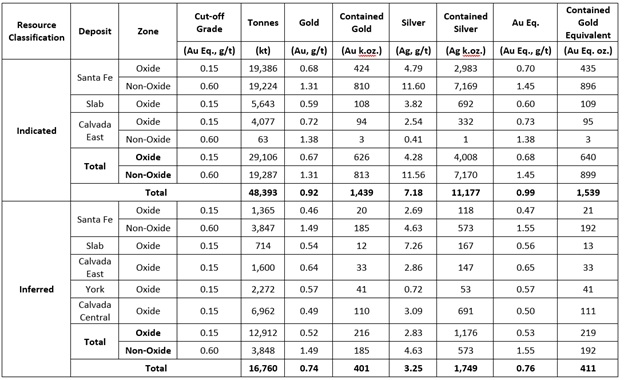
Notes to Table 6:
- Mineral Resources have an effective date of October 9, 2024. The Mineral Resource Estimate for the Santa Fe Mine was prepared by Trevor Rabb, P.Geo., of Equity Exploration Consultants Ltd., an independent Qualified Person as defined by NI 43-101.
- Mineral Resources are not Mineral Reserves and do not have demonstrated economic viability. Inferred Resources are considered too speculative geologically to have economic considerations applied to them that would enable them to be classified as Mineral Reserves. An Inferred Mineral Resource has a lower level of confidence than that applying to an Indicated Mineral Resource and must not be converted to a Mineral Reserve. It is reasonably expected that most of the Inferred Mineral Resources could be upgraded to Indicated Mineral Resources with continued exploration.
- Resources are reported in accordance with NI43-101 Standards of Disclosure for Mineral Projects (BCSC, 2016) and the CIM Definition Standards for Mineral Resources and Mineral Reserves (CIM, 2014).
- Mineral Resources were estimated for gold, silver, and gold equivalent (Au Eq) using a combination of ordinary kriging and inverse distance cubed within grade shell domains.
- Mineral resources are reported using a cut-off grade of 0.15 g/t Au Eq for oxide resources and 0.60 g/t Au Eq for non-oxide resources. Au Eq for the purpose of cut-off grade and reporting the Mineral Resources is based on the following assumptions gold price of US$1,950/oz gold, silver price of US$23.50/oz silver, and oxide gold recoveries ranging from 45% to 79%, oxide silver recoveries ranging from 10% to 30%, and non-oxide gold and silver recoveries of 71%, mining costs for resource and waste of US$2.50/t, processing cost (oxide) US$3.49/t, processing cost (non-oxide) US$25/t.
- An optimized open-pit shell was used to constrain the Mineral Resource and was generated using Lerchs-Grossman algorithm utilizing the following parameters: gold price of US$1,950/oz gold, silver price of US$23.50/oz silver, and selling costs of US$29.25/oz gold. Mining costs for resource and waste of US$2.50/t, processing cost (oxide) US$3.49/t, processing cost (non-oxide) US$25/t, G&A cost US$1.06/t. Royalties for the Slab, York and Calvada deposits are 1.25%, and maximum pit slope angles of 50 degrees.
- Totals may not sum due to rounding.
Estimation Approach: Lithology and gold and silver bearing domains were modelled using Leapfrog 2024. These domains are mainly defined by logged jasperoid and limestone-breccia lithologies and continuity of gold grades above 0.1 g/t gold. Metallurgical domains for oxide, transition and non-oxide were modelled based on ratio of cyanide leachable gold assay values to fire assay gold values in addition to drillhole logs recording abundance of pyrite and oxidation intensity. Transition material represents approximately 35% of oxide tonnes and comes almost entirely from the Santa Fe deposit. Transition domain material is included in the oxide resource. Domains representing lithology, weathering and mineralization models were assigned to a block model with a block size of 5 m x 5 m x 6 m. Average bulk densities representative of the mineralization and lithology models were assigned to the block model and vary from 2.4 t/m3 to 2.6 t/m3.
Grade capping and outlier restrictions were applied to gold and silver values and interpolation parameters respectively. Top cut values for gold and silver were evaluated for each domain independently prior to compositing to 1.52 m lengths that honor domain boundaries. Estimation was completed using Micromine Origin with Ordinary Kriging (OK) and Inverse Distance cubed (ID3) interpolants. Blocks were classified in accordance with the 2014 CIM Definition Standards. The nominal drillhole spacing for Indicated Mineral Resources is 50 m or less. The nominal drillhole spacing for Inferred Mineral Resources is 100 m or less.
Prospects for eventual economic extraction were evaluated by performing pit optimization using Lerchs-Grossman algorithm with the following parameters: gold price of US$1,950/oz gold, silver price of US$23.50/oz silver, selling costs of US$29.25/oz gold. Mining costs for resource and waste of US$2.50/t, processing cost (oxide) US$3.49/t, processing cost (non-oxide) US$25/t, G&A cost US$1.06/t. Royalties for the Slab, York and Calvada deposits are 1.25%. Maximum pit slope is 50 degrees. Processing recoveries range from 45% to 79% for oxide, silver recoveries range from 10% to 30% for oxide and non-oxide gold and silver recoveries are 71%.
More information regarding the Santa Fe Mine project's MRE update is included in the NI 43-101 Technical Report titled Santa Fe Project Technical Report with an effective date of October 9, 2024, Report Date: November 27, 2024*.
Qualified Persons
The qualified persons are Kenji Umeno, P.Eng. of Kappes, Cassiday & Associates; Thomas Dyer, P.E. of RESPEC; Trevor Rabb, P.Geo. and Darcy Baker, P.Geo. of Equity Exploration Consultants Ltd. each of whom is an independent "Qualified Person" under NI 43-101. A technical report supporting the results disclosed herein will be published within 45 days. The effective date of the technical report will be December 10, 2024.
About Lahontan Gold Corp.
Lahontan Gold Corp. is a Canadian mine development and mineral exploration company that holds, through its US subsidiaries, four top-tier gold and silver exploration properties in the Walker Lane of mining friendly Nevada. Lahontan's flagship property, the 26.4km2 Santa Fe Mine project, had past production of 356,000 ounces of gold and 784,000 ounces of silver between 1988 and 1995 from open pit mines utilizing heap-leach processing (Nevada Division of Minerals, www.ndomdata.com). The Santa Fe Mine has a Canadian National Instrument 43-101 compliant Indicated Mineral Resource of 1,539,000 oz Au Eq(grading 0.99 g/t Au Eq) and an Inferred Mineral Resource of 411,000 oz Au Eq (grading 0.76 g/t Au Eq), all pit constrained (Au Eq is inclusive of recovery, please see Santa Fe Project Technical Report*). For more information, please visit our website: www.lahontangoldcorp.com
* Please see the Santa Fe Project Technical Report, Authors: Trevor Rabb, P. Geo, Darcy Baker, PhD, P. Geo., and Kenji Umeno, P. Eng., Effective Date: October 9, 2024, Report Date: November 27, 2024. The Technical Report is available on the Company's website and SEDAR+.
On behalf of the Board of Directors
Kimberly Ann
Founder, CEO, President, and Director
FOR FURTHER INFORMATION, PLEASE CONTACT:
Lahontan Gold Corp.
Kimberly Ann
Founder, Chief Executive Officer, President, Director
Phone: 1-530-414-4400
Email: Kimberly.ann@lahontangoldcorp.com
Website: www.lahontangoldcorp.com
Cautionary Note Regarding Forward-Looking Statements:
This news release contains "forward-looking statements" and "forward-looking information" (collectively, "forward-looking statements") within the meaning of Canadian and United States securities legislation, including the United States Private Securities Litigation Reform Act of 1995. All statements, other than statements of historical fact, are forward-looking statements. Forward-Looking statements in this news release relate to, among other things: the Company's strategic plans; the results of the PEA; the economic potential and merits of the Project; the estimated amount and grade of mineral resources at the Project; precious metals prices; the PEA representing a viable development option for the Santa Fe Mine project ("the Project"); the timing and particulars of the development phases as identified in the PEA; estimates with respect to LOM, operating costs, sustaining capital costs, capex, AISC, cash costs, LOM production, processing plant throughput, NPV and after-tax IRR, payback period, production capacity and other metrics; the estimated economic returns from the Project; mining methods and extraction techniques; the exploration potential of the Project and its inclusion in future mining studies.
These forward-looking statements reflect the Company's current views with respect to future events and are necessarily based upon several assumptions that, while considered reasonable by the Company, are inherently subject to significant operational, business, economic and regulatory uncertainties and contingencies. These assumptions include, among other things: conditions in general economic and financial markets; tonnage to be mined and processed; grades and recoveries; prices for silver and gold remaining as estimated; currency exchange rates remaining as estimated; reclamation estimates; reliability of the updated MRE and the assumptions upon which it is based; future operating costs; prices for energy inputs, labor, materials, supplies and services (including transportation); the availability of skilled labor and no labor related disruptions at any of the Company's operations; no unplanned delays or interruptions in scheduled production; performance of available laboratory and other related services; availability of funds; all necessary permits, licenses and regulatory approvals for operations are received in a timely manner; the ability to secure and maintain title and ownership to properties and the surface rights necessary for operations; and the Company's ability to comply with environmental, health and safety laws. The foregoing list of assumptions is not exhaustive.
Neither TSX Venture Exchange nor its Regulation Services Provider (as that term is defined in policies of the TSX Venture Exchange) accepts responsibility for the adequacy or accuracy of this release. Except for statements of historical fact, this news release contains certain "forward-looking information" within the meaning of applicable securities law. Forward-looking information is frequently characterized by words such as "plan", "expect", "project", "intend", "believe", "anticipate", "estimate" and other similar words, or statements that certain events or conditions "may" or "will" occur. Forward-looking statements are based on the opinions and estimates at the date the statements are made and are subject to a variety of risks and uncertainties and other factors that could cause actual events or results to differ materially from those anticipated in the forward-looking statements including, but not limited to delays or uncertainties with regulatory approvals, including that of the TSXV. There are uncertainties inherent in forward-looking information, including factors beyond the Company's control. The Company undertakes no obligation to update forward-looking information if circumstances or management's estimates or opinions should change except as required by law. The reader is cautioned not to place undue reliance on forward-looking statements. Additional information identifying risks and uncertainties that could affect financial results is contained in the Company's filings with Canadian securities regulators, which filings are available at www.sedar.com
Latest News

Impact Minerals Limited Investor Kit
- Corporate info
- Insights
- Growth strategies
- Upcoming projects
GET YOUR FREE INVESTOR KIT
Latest Press Releases
Related News
TOP STOCKS
Investing News Network websites or approved third-party tools use cookies. Please refer to the cookie policy for collected data, privacy and GDPR compliance. By continuing to browse the site, you agree to our use of cookies.


